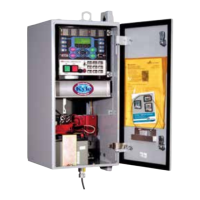Metering
The control provides instantaneous and/or demand
metering with programmable integration intervals for the
following functions:
• Real and reactive power for each phase and total,
including directional, on an individual phase basis.
• Demand currents on a per phase basis.
• Instantaneous currents, including ground current.
• Instantaneous voltage on a per phase basis.
• Instantaneous frequency.
• Positive, negative, and zero sequence voltages.
• Instantaneous power factor on a per phase basis.
• Metering settings to include demand interval, and
alarm thresholds for current, single-phase kW, three-
phase kW, single-phase kvar, and three-phase kvar.
Event Recorder
The Form 6 control contains capabilities to perform
Sequence of Events time-stamping for up to 33 event
types. Sixteen additional inputs can be user-defined
through the Idea Workbench.
Factory-defined event types include:
• Overcurrent Protection Trip
• External Trip
• Non-Reclose Trip
• External Close
• Lockout
• Reset
The Event Recorder maintains a minimum of 90 event
records. The last 25 events are viewable on the front panel
LCD display. Refer to S280-70-4 (ProView 4.X.X) or S280-
70-21 (ProView 5.X.X) Form 6 Control Programming Guide
for additional information.
Recloser Duty Monitor
The Form 6 recloser control software is equipped with a
Recloser Interrupting Duty Monitor. The Duty Monitor
accumulates the summation of I
1.5
for all interrupted
currents on each interrupter. This feature permits
programmable entries to preset the duty of an existing
recloser. The recloser duty monitor displays interrupting
duty in percent of duty used. If the duty cycle monitor
exceeds 100%, the recloser should be examined for
maintenance.
Discrete SCADA Communications
The control provides five configurable output status con-
tacts and three configurable input control contacts as
standard. Each status contact is configurable using graph-
ical interface software to combine status functionality along
with Boolean algebra. Default output status contacts are:
Lockout, Recloser Open, Recloser Closed, Ground Trip
Block, and Hot Line Tag. One output status contact is a
solid state output (SS1) with a pickup time no longer than
two milliseconds.
The control also provides a minimum of three configurable
input control contacts. Each control contact is configurable
using a graphical interface software. Contacts accept a
whetting voltage range of 12–250 VDC, 120/240 VAC.
Each digital input is configured for either a momentary,
maintained, or maintained with precedence contact. Default
input control contacts are: Supervisory Trip and Lockout,
Supervisory Close, and Remote Trip and Lockout.
A Discrete Interface Board is also available as an accessory
to provide an additional eight output status contacts and
eight input control contacts. The expansion I/O board is
completely user-configurable.
TCC Editor II
Coordination and actual time current modifications are
available with a graphic interactive TCC Editor or similar
graphical software.
The TCC Editor II includes a complete database of
standard recloser industry time current curves (TCC), both
ANSI and IEC types, along with the ability to customize the
TCCs with multipliers, constant time adders, or minimum
response time adders. Also, the user is able to derive their
own specific TCC through data point entry. Each modified
time current curve can be identified with a user-customized
name and is selectable for configuring the control. The grid
and format for presenting the TCCs has a user-adjustable
scale, including the option of presenting multiple TCCs in
various user-configured colors.
Oscillography
Oscillography is provided to present current and voltage
waveforms, along with protection element and recloser
response status changes. Filtered and unfiltered data are
provided for viewing.
The recorded values are super-imposed on the protection
scheme, and the state or value at any point in the scheme
is displayed. The user has the capability to move through
the event and watch the response of every function. All
analog signals, digital inputs, and contact outputs are
monitored. Analog oscillography is displayed at 16 samples
per cycle.
Oscillographic data is recorded to analyze multiple events
during a permanent fault or other event type. The
oscillographic data shows two cycles before the trigger
point and eight cycles after the trigger point (default).
Note: The configuration settings are programmable.
Oscillography automatically initiates trigger points for the
following functions:
• Above Minimum Trip for Phase, Ground, and Sensitive
Ground Fault
• Single- and Three-Phase Overvoltage
• Single- and Three-Phase Undervoltage
• Over- and Underfrequency
• Trip Signal Issued
• Close Signal Issued
Form 6 Microprocessor-Based Pole-mount Recloser Control Installation and Operation Instructions
12

